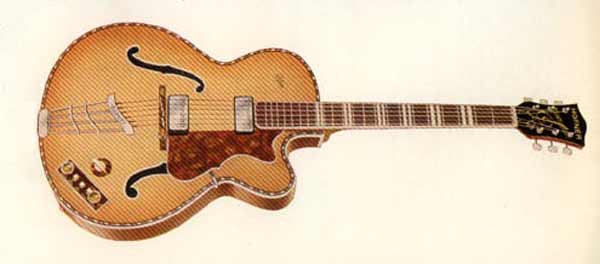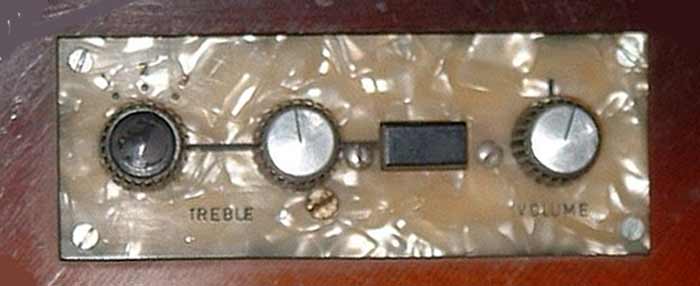
HOFNER ACTIVE ELECTRONICS
- FACT FILE

Hofner's
use of active electronics as an option on their guitars seems to have
occurred in four main phases:
- During the
mid/late 1950's and into the 1960's, when the option of having a simple
pre-amp circuit was offered
on all electric archtop guitar models.
- From around
1963, an electronic
tremolo circuit could be added
to the previous pre-amp circuit on archtop guitars. In addition,
non-active stereo circuits were offered on some semi-acoustic guitars.
- From c1967
through to the end of the 1970's, when a much expanded range of effects
options was offered in conjunction with special control consoles. These
electronics were offered mainly as options (but also as standard
equipment on some models) on electric archtop guitars and some
semi-acoustic bass guitars.
- During
the 1980's and into the 90's, when active circuits were built into many
of the "new generation" Hofner semis and solid guitars.
PHASE 1 - Simple Pre-Amps - Mid 1950's to Mid 1960's
Hofner were
one of the very first
manufacturers to offer active circuits in their guitars. They were
basically introduced for players who did not use a conventional guitar
amplifier, but who could plug into a domestic radio set or radiogram.
The idea was that the active circuit would boost the signal to the
radio receiver, hence increasing volume and improving the tone. As the
Hofner catalogue stated:
"Our
new electrc
guitars with built-in audio-frequency pre-amplifier can be connected
with any radio without a special amplifying set and will still attain a
superb tone quality never effected up till now. Therefore it is not
necessary anymore to purchase an expensive amplifier. "
The circuit was powered
by a 1.5 volt
torch battery which was fitted into a special compartment, usually
adjacent to the strap button at the bottom of the body in the guitar's
side. This was covered by a nickel plated swivel cap. A three
way
chicken-head control was fitted to the body top which allowed the
following functions:
- All electrics turned off, allowing the guitar to
be played as a full acoustic.
- Passive circuits turned for playing through a
conventional amplifier.
- Active circuit switched on for playing through a
radio, or indeed a conventional amplifier.
The model number
of the particular
guitar was given a "T" designation to indicate that it was a
"transistor powered" instrument. i.e. a conventional 457/S/E2 archtop
with normal passive electrics and two pickups would be designated as a
457/S/T2 if the optional active circuit was fitted. A single pickup
active 457 guitar would be a 457/S/T1 and with three pickups - 457/S/T3.
If
Type 511 "staple" pickups
were fitted, the model designation would be 457/S/T20, although by that
late stage very few active circuits were being fitted.
A c1963
Hofner Model 463/S/T2
The
pre-amp option does not seem to have been offered on those guitars
supplied to the Selmer Company.
EXAMPLES OF ACTIVE HOFNER GUITARS FROM THIS PERIOD:
PHASE II - Introduction of Electronic Tremolo Effect - 1960 to 1962
In
1960 Hofner offered an addition to the onboard pre-amp, in the form of a
tremolo circuit. A three-way selector switch acted both as an on/off switch
and tremelo speed control, and this was supplemented by an adjacent rotary pot on
the body top which controlled tremolo intensity, A single selector switch turned the effect on and off
without effecting the pre-set settings. This option was available for only
two years or so. Hence, guitars so
equipped are very rare.
Such guitars were given a "V" designation.
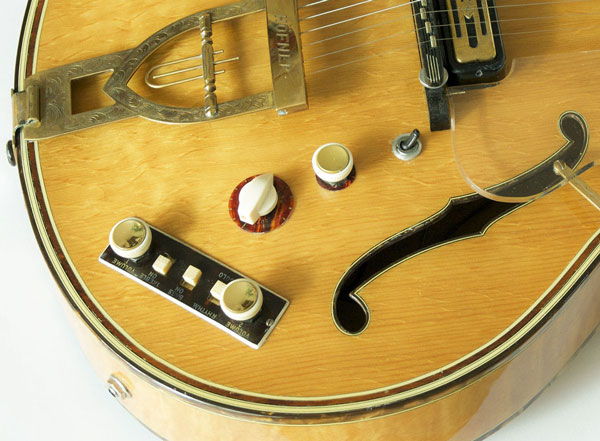
The above photo shows a 1960
Hofner 470/S/E2V, owned by Dieter Serowy and fitted with the electronic tremolo circuit
described above. The chicn-head
rotary knob controls the tremolo speed as well as being an on-off switch. The other
rotary knob with the "tea-cup" head controls the tremolo depth/intensity. The switch to the right of the conventional control console
turns the tremolo effect on and off. Further details and photos of this
470/S/E2V can be found HERE.
During this period, Hofner also
offered a passive stereo circuit option for their archtop and
semi-acoustic guitars. This is most often seen fitted to the
Selmer-distributed Hofner Verithin Stereo between 1963 and 1965. To see
an example of such a guitar, click HERE.
For a short period in 1960,
Hofner experimented with two battery-operated guitars fitted with a
built-in amplifier and loudspeaker. This equipment was fitted to the
126 "Club" model (Hofner 1260) and a totally new (and totally wierd!)
guitar designed called the Fledermausguitarre, also known as the Hofner
Bat Guitar. These guitars, particularly the Bat Guitar, were made in
very small numbers and hence can really be considered to be only
prototypes and /or exhibition guitars.

The
Fledermausguitarre
The Hofner Model 1260
PHASE III - Active Effects Built Into Dedicated Control Consoles -
Mid-1960's through into the 1970's.
Following on from their earlier forays into
active guitar circuitry as described above, Hofner
consolidated their previous efforts at active circuitry into the
production of dedicated control consoles with all active circuits built
in. This resulted in the offering of more effects options and getting
rid of the dis-jointed knobs and switches, and hence improved the
appearance of the active guitars body tops. In addition, the battery
holder location was changed from the bottom edge of the body to the
rear of the body. It all gave the impression that Hofner were now
serious about their active electronics, and certain models, both
conventional 6-string and bass, were marketed strongly as active models.
It would seem that Hofner initially set about the task by using a console
format which was very similar to the old E1 and E2
rectangular consoles - i.e. rectangular is shape and with pearloid
facings. (See the treble boost photo below.) However, possibly due to
the requirement for having more effects on a guitar than a small console
could contain, large semi-circular consoles were soon developed, which
fitted snugly into the lower bout curve of the guitar or
bass. The various effects offered either singly or in
combination are listed below, together with the designation letter that
Hofner gave them:
Bass
Boost - "B"
Sound Mix - "M"
Treble Boost - "T"
Wah Effect - "W"
Fuzz Tone - "Z"
In addition, those guitars also fitted with a Vibrato Tailpiece also
were given a "V" designation.
Examples of various active control panels used during this period are
provided below:
Rectangular
Console Type - Treble Boost (T)
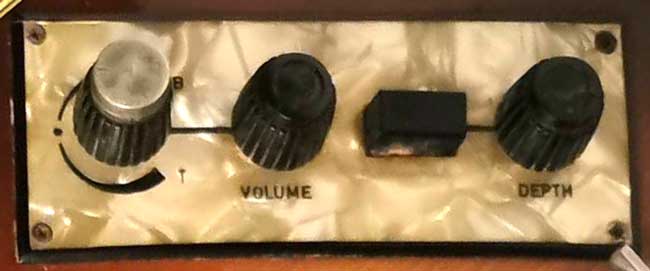
Rectangular Console Type -
Distortion (Z) and variable pickup rotary selector.
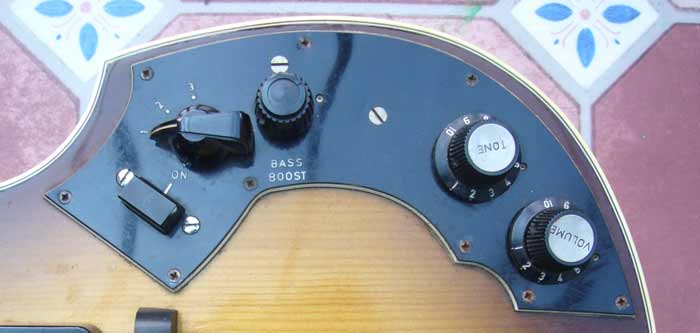
Bass
Boost (B) fitted on a Hofner 500/1B Bass Guitar.
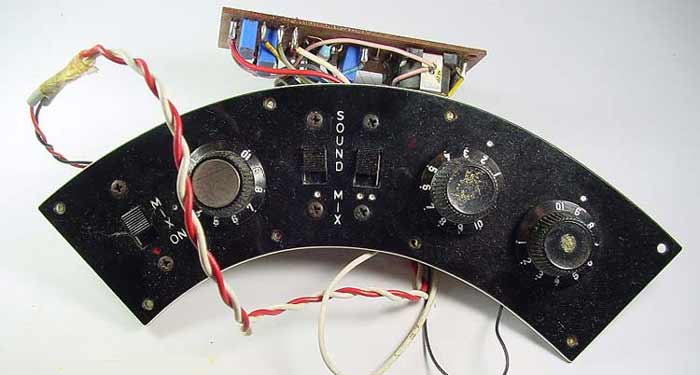
Sound
Mix (M) with slide-switches for two pickups on guitars and basses.
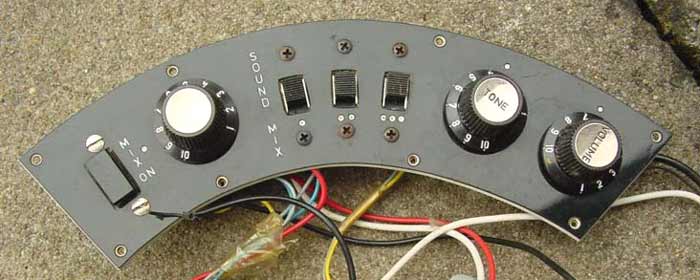
Sound
Mix (M) with three slide-switches for three pickup guitars.
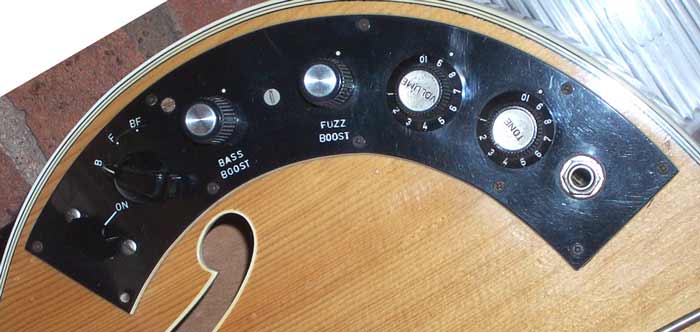
Bass Boost and Fuzz Tone
(BZ) fitted to a Hofner 500/8 Bass Guitar
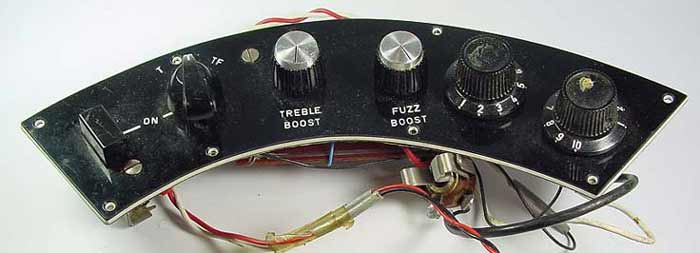
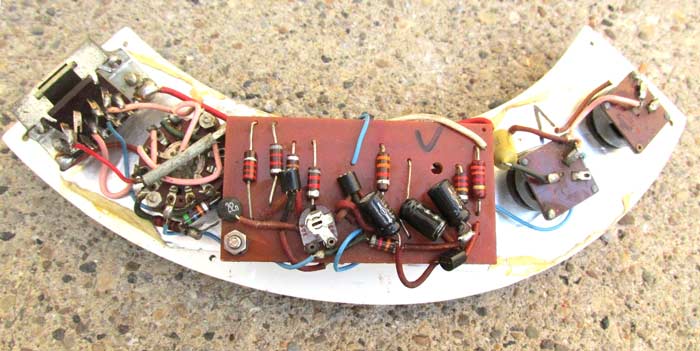
Treble
Boost and Fuzz Tone (TZ)
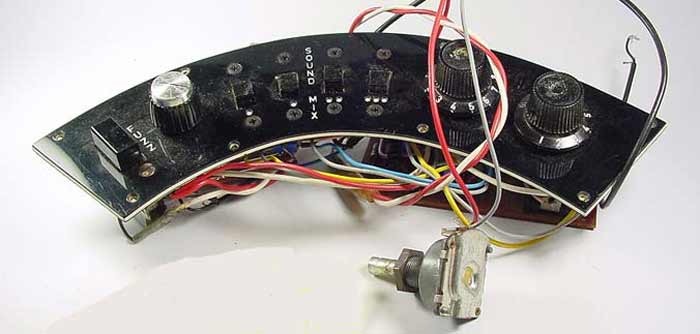
Sound Mix, Fuzz Tone, and Wah
Wah. (WZM)
EXAMPLES OF ACTIVE HOFNER GUITARS FROM THIS PERIOD:
PHASE IV - ACTIVE ELECTRICS INTO THE 1980'S, & THE
NEW GENERATION HOFNERS OF THE LATE 1980's
Hofner still
continued its tradition of offering the guitarist guitars with active
circuitry during the 1980's, but the emphasis was back on the boosting
of signal and tone-gain, rather than on specialised effects such as
tremolo, fuzz, and wah. Many of the Hofner "S" series solid guitar
models and "T" series semis had active circuits as standard, and not just as
an option. Examples of these can be found at:
An
echo from the early 1960's did however appear, in the form of the
Hofner "Shorty Super" Model 181 which appeared in 1982 with an in-built
amplifier and loudspeaker. The concept of the Shorty travel guitar
fitted in well with not having to carry a seperate combo amp around !
The dynamic new
range of Hofner solids and semi's that were introduced in the late
1980's brought many innovations to the old brand. However, the use of
active electrics was by then on its way out. The following is an
example of the
much fewer Hofner guitars fitted with active electrics from this period:
There are now no guitars or basses with active electronics in the current Hofner range.
© Steve Russell 2008
All rights reserved



